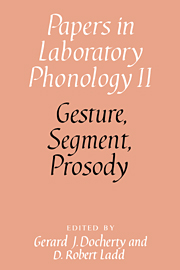Book contents
- Frontmatter
- Contents
- List of contributors
- Acknowledgments
- Introduction
- Section A Gesture
- Section B Segment
- Section C Prosody
- 13 An introduction to intonational phonology
- 14 Downstep in Dutch: implications for a model
- 15 Modeling syntactic effects on downstep in Japanese
- 16 Secondary stress: evidence from Modern Greek
- Appendix 1 The test phrases (bold type) of experiment 1 in the context in which they were read
- Appendix 2 The distractors (bold type) of experiment 1 in the context in which they were read
- Appendix 3 The test sentences of experiment 2. The test words are in bold type
- Appendix 4 The distractor sentences of experiment 2. The distractors are in bold type
- References
- Name index
- Subject index
14 - Downstep in Dutch: implications for a model
from Section C - Prosody
Published online by Cambridge University Press: 18 December 2009
- Frontmatter
- Contents
- List of contributors
- Acknowledgments
- Introduction
- Section A Gesture
- Section B Segment
- Section C Prosody
- 13 An introduction to intonational phonology
- 14 Downstep in Dutch: implications for a model
- 15 Modeling syntactic effects on downstep in Japanese
- 16 Secondary stress: evidence from Modern Greek
- Appendix 1 The test phrases (bold type) of experiment 1 in the context in which they were read
- Appendix 2 The distractors (bold type) of experiment 1 in the context in which they were read
- Appendix 3 The test sentences of experiment 2. The test words are in bold type
- Appendix 4 The distractor sentences of experiment 2. The distractors are in bold type
- References
- Name index
- Subject index
Summary
Introduction
In this paper we attempt to identify the main parameters which must be included in a realistic implementation model for the intonation of Dutch. The inspiration for our research was provided by Liberman and Pierrehumbert (1984) and Ladd (1987a). A central concern in those publications is the phonological representation and the phonetic implementation of descending intonation contours. The emphasis in our research so far has likewise been on these issues. More specifically, we addressed the issue of how the interruption of downstep, henceforth referred to as reset (Maeda 1974; Cooper and Sorensen 1981: 101) should be represented. Reset has been viewed as (a) an upward register shift relative to the register of the preceding accent, and (b) as a local boost which interrupts an otherwise regular downward trend. We will argue that in Dutch, reset should be modeled as a register shift, but not as an upward shift relative to the preceding accent, but as a downward one relative to a preceding phrase. Accordingly, we propose that a distinction should be made between accentual downstep (which applies to H relative to a preceding H inside a phrase), and phrasal downstep, which reduces the range of a phrase relative to a preceding phrase, and creates the effect of reset, because the first accent of the downstepped phrase will be higher than the last downstepped accent of the preceding phrase.
We will present the results of two fitting experiments, one dealing with accentual downstep, the other with phrasal downstep.
- Type
- Chapter
- Information
- Gesture, Segment, Prosody , pp. 335 - 367Publisher: Cambridge University PressPrint publication year: 1992
- 17
- Cited by

